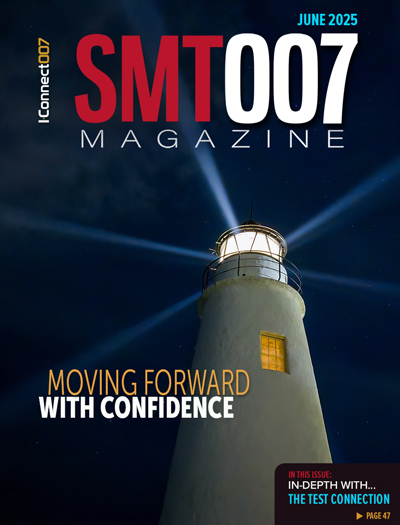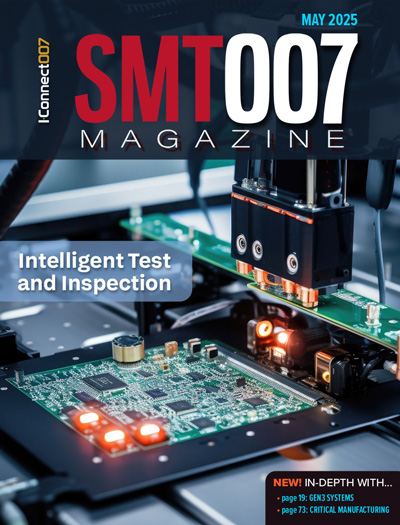-

- News
- Books
Featured Books
- smt007 Magazine
Latest Issues
Current Issue
What's Your Sweet Spot?
Are you in a niche that’s growing or shrinking? Is it time to reassess and refocus? We spotlight companies thriving by redefining or reinforcing their niche. What are their insights?

Moving Forward With Confidence
In this issue, we focus on sales and quoting, workforce training, new IPC leadership in the U.S. and Canada, the effects of tariffs, CFX standards, and much more—all designed to provide perspective as you move through the cloud bank of today's shifting economic market.

Intelligent Test and Inspection
Are you ready to explore the cutting-edge advancements shaping the electronics manufacturing industry? The May 2025 issue of SMT007 Magazine is packed with insights, innovations, and expert perspectives that you won’t want to miss.
- Articles
- Columns
- Links
- Media kit
||| MENU - smt007 Magazine
Superconductivity Seen in a New Light
March 31, 2016 | Université de GenèveEstimated reading time: 2 minutes
Superconducting materials have the characteristic of letting an electric current flow without resistance. The study of superconductors with a high critical temperature discovered in the 1980s remains a very attractive research subject for physicists. Indeed, many experimental observations still lack an adequate theoretical description. Researchers from the University of Geneva (UNIGE) in Switzerland and the Technical University Munich in Germany have managed to lift the veil on the electronic characteristics of high-temperature superconductors. Their research, published in Nature Communications, show that the electronic densities measured in these superconductors are a combination of two separate effects. As a result, they propose a new model that suggests the existence of two coexisting states rather than competing ones as was postulated for the past thirty years. A small revolution in the world of superconductivity.
A superconducting material is a material that, below a certain temperature, loses all electrical resistance (equal to zero). When immersed in a magnetic field, high-temperature superconductors (high-Tc) allow this field to penetrate in the form of filamentary regions, called vortices, in which the material is no longer superconducting. Each vortex is a whirl of electronic currents generating their own magnetic field and in which the electronic structure is different from the rest of the material.
Coexistence rather than competition
Some theoretical models describe high-Tc superconductors as a competition between two fundamental states, each developing its own spectral signature. The first is characterized by an ordered spatial arrangement of electrons. The second, corresponding to the superconducting phase, is characterized by electrons assembled in pairs.
«However, by measuring the density of electronic states with local tunneling spectroscopy, we discovered that the spectra that were attributed solely to the core of a vortex, where the material is not in the superconducting state, are also present elsewhere, that is to say in areas where the superconducting state exists. This implies that these spectroscopic signatures do not originate in the vortex cores and cannot be in competition with the superconducting state», explains Christoph Renner, professor in the Department of Quantum Matter Physics of the Faculty of Science at UNIGE. «This study therefore questions the view that these two states are in competition, as largely assumed until now. Instead, they turn out to be two coexisting states that together contribute to the measured spectra», professor Renner says. Indeed, physicists from UNIGE have shown, using theoretical simulation tools, that the experimental spectra can be reproduced perfectly by considering the superposition of the spectroscopic signature of a superconductor and this other electronic signature, brought to light through this new research.
This discovery is a breakthrough towards understanding the nature of the high temperature superconducting state. It puts some theoretical models based on the competition of the two states mentioned above in difficulty. It also sheds new light on the electronic nature of the vortex cores, which potentially has an impact on their dynamics. Mastery of this dynamics, and particularly of the anchoring of vortices that depend on their electronic nature, is critical for many applications, such as high field electromagnets.
Testimonial
"Our marketing partnership with I-Connect007 is already delivering. Just a day after our press release went live, we received a direct inquiry about our updated products!"
Rachael Temple - AlltematedSuggested Items
SMTA International Technical Conference Program Announced
07/22/2025 | SMTAThe SMTA announced that the technical program of their annual conference, SMTA International, is finalized and registration is now open. The event will be held October 19 - 23, 2025 at the Donald E. Stephens Convention Center in Rosemont, IL, USA.
SisTech Manufacturing Leads the Charge Against Electronic Component Obsolescence with Innovative Solutions
07/22/2025 | Globe NewswireSisTech Manufacturing recently rolled out advancements to its Electronic Manufacturing Services. These updates underscore the company's dedication to streamlining production processes while maintaining high quality and precision for their diverse clients.
Federal Electronics Continues to Enhance Inspection Capabilities at Hermosillo Facility: Installs New Mycronic PI Primo M 3D SPI System
07/22/2025 | Federal ElectronicsFederal Electronics, a leader in providing advanced electronic manufacturing services, has installed a new Mycronic PI Primo M 3D Solder Paste Inspection (SPI) system at its Hermosillo, Mexico facility, advancing the site’s precision inspection and process control capabilities.
Flip Electronics Unifies Manufacturing Operations Under New Flip Manufacturing Services Brand
07/22/2025 | PRNewswireFlip Electronics, an authorized distributor of obsolete semiconductors and electronic components, announced that it is rebranding its subsidiary, Resurgent Manufacturing Services, to Flip Electronics Manufacturing Services (FMS).
Powering Progress: Summer 2025 Community Magazine Now Available
07/22/2025 | Community MagazineIn the new Summer 2025 edition of Community Magazine, members of the Global Electronics Association demonstrate what progress really looks like—through innovation on the factory floor, influence on public policy, and investment in the next generation of engineers.


